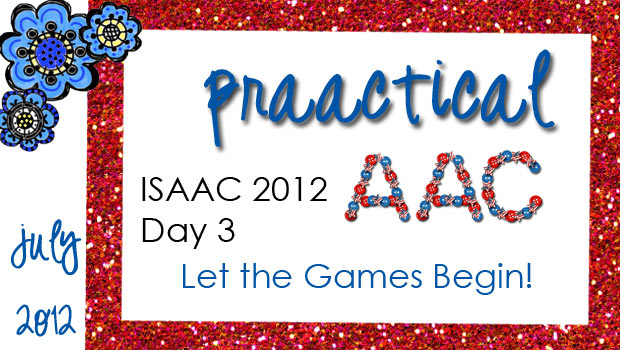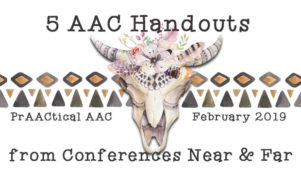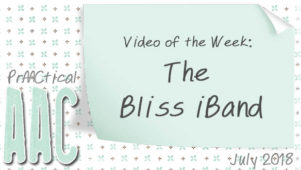ISAAC 2012, Day 3: Let the Games Begin!

Today was the first day of the main conference and it did not disappoint. The conference began with a plenary session that was moving beyond words. For me, the highlight was Peter Yarrow, of Peter, Paul, and Mary fame joined in song by conference co-chair Katya Hill, and Snoopi Botten, who sings using AAC. Hearing the three of them sing songs like Puff the Magic Dragon and others made popular in the civil rights area did much to reinforce the notion that communication is a basic human right. The ongoing struggle to make that right accessible to all was highlighted in a speech by ISAAC president, Erna Alant, of South Africa, who rekindled our commitment to this effort. Another wonderful aspect of the plenary was the parade of nations, AAC style. Snoopi sang as the flags of the ISAAC members’ countries were displayed, and there were rousing cheers for all those represented.
–
The plenary was followed by the opening of the Exhibit Hall (more about that later) and about 8-10 poster sessions. There was a lot of wonderful information shared on a wide variety of topics. Included were presentations on consumer protection and AAC (Hill & Taylor), navigation strategies by people with aphasia (Wallace), friendship (Stuart & Estrella), user perceptions (Moreschi), the Pittsburgh Employment Conference (Baker & Klein), personal experiences with AAC (O’Gurek), SGD interfaces for people with aphasia (Steele), and auditory dysynchrony (Zangari & Paiva). The room was buzzing for the full 90 minutes.
–
In the afternoon, there was a session by one of giants in the AAC field, Shirley McNaughton, who presented with Peter Zein on Blissymbolics – Bliss is not often seen in the US, and that is a real loss to the many who could benefit from linguistic power it offers.
–
I also presented on the topic of online tools that AAC practitioners can use in their teaching and clinical/educational work. You can view that handout here.
–
Gail Teachman presented a review and critique of a construct familiar to most AAC practitioners in AAC, communicative competence. She discussed some of the theoretical underpinnings, underlying assumptions, and challenged participants consider alternative ways to conceptualize communicative competence.
–
AAC in the schools is a topic of great interest to me and so I wanted to mention a presentation by Angela Mezzomo. AAC in the Classroom: Whose Job is it Anyway? focused on 7 core components for providing classroom AAC support. There were
/ISAAC_AAC_online.png) interesting points made around the need for improved pre-service training for teachers and other school-based professionals.
interesting points made around the need for improved pre-service training for teachers and other school-based professionals.
–
The day ended with a Welcome Reception on the Rooftop Terrace that offered an opportunity to meet with friends, new and old.
–
Want more frequent updates? Follow #ISAAC2012 on Twitter for highlights and perspectives of AAC stakeholders from around the world.
–
Filed under: PrAACtical Thinking
Tagged With: #ISAAC2012, Bliss, Conference, ISAAC, Shirley McNaughton
This post was written by Carole Zangari






3 Comments
Carole, thanks so much for keeping us updated with all things ISAAC2012, there are plenty of us around the world who wish we could be there, learning and sharing – so thank you for keeping us in the loop. I would love to hear more about the 7 core components for providing classroom AAC support as presented by Angela Mezzomo if you have a chance to expand. Thanks! Enjoy!
Laura, thanks for your comment and kind words. I am off to a session but also wanted to share that Kate Ahern is doing a great job at this. You can see her videos at http://bit.ly/Mw2iyL.
Hi Laura,
I just came across your question and wanted to make sure you received an answer. The 7 classroom AAC supports are based o my 7 survey questions and responses. They included:
1: Who should be responsible to decide which device is appropriate for the student? Team
2: Who should be responsible to seek funding for the device? ATC
3: Who should be responsible to decide on device vocabulary? SLP & Teacher
4: Who should be responsible to create overlays/symbols for the device? SLP & Teacher
5: Who should be responsible to make sure the device is ready for use? teacher
6: Who should be responsible to make sure the student uses the device? teacher
7: Who should be responsible to update and maintain the device? ATC
The professional(s) identified in survey results as the one(s) who should be responsible are listed at the end of each question. I hope this helps.
Angela Mezzomo